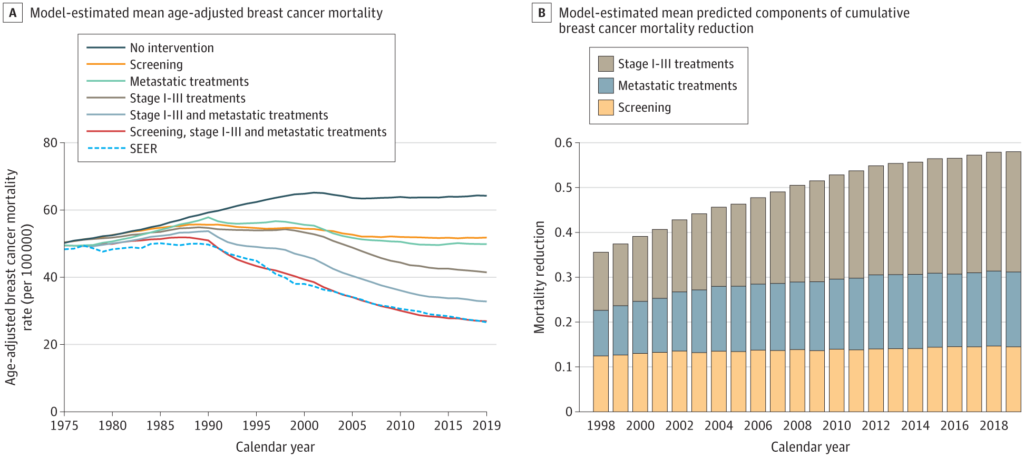That’s the reply Caswell-Jin et al. (2024) purpose to reply. The authors used 4 most cancers mortality fashions inside CISNET for this research:
- Mannequin D (Dana-Farber Most cancers Institute). Used to outline a set of illness states and carried out analytic formulations to estimate the affiliation of interventions on transitions between these states, in addition to on breast most cancers incidence and mortality.
- Mannequin M (MD Anderson Most cancers Heart). Relied on a a bayesian strategy, which asseded the likelihood distributions for unknown parameters, together with remedy advantages, and becoming to noticed breast most cancers mortality
- mannequin S (Stanford College). A microsimulation that modelled pure historical past of illness based mostly on tumor measurement and stage development mapped to detection; remedies advantages have been utilized to baseline survival curves based mostly on stage, age, and estrogen receptor (ER)/ERBB2 (previously HER2) standing at detection.
- mannequin W (College of Wisconsin–Harvard). This mannequin used a tumor development framework and was calibrated incidence and mortality based mostly on Surveillance, Epidemiology, and Finish Outcomes Program (SEER) registry. This mannequin additionally included a treatment fraction.
Classes of breast most cancers by ER/ERBB2 standing (ER+/ERBB2−, ER+/ERBB2+, ER−/ERBB2+, and ER−/ERBB2−) have been modelled individually.
Utilizing this strategy, the authors discovered that:
The breast most cancers mortality fee within the US (age adjusted) was 48/100 000 ladies in 1975 and 27/100 000 ladies in 2019. In 2019, the mixture of screening, stage I to III remedy, and metastatic remedy was related to a 58% discount (mannequin vary, 55%-61%) in breast most cancers mortality. Of this discount, 29% (mannequin vary, 19%-33%) was related to remedy of metastatic breast most cancers, 47% (mannequin vary, 35%-60%) with remedy of stage I to III breast most cancers, and 25% (mannequin vary, 21%-33%) with mammography screening. Primarily based on simulations, the best change in survival after metastatic recurrence occurred between 2000 and 2019, from 1.9 years (mannequin vary, 1.0-2.7 years) to 3.2 years (mannequin vary, 2.0-4.9 years).

You possibly can learn the complete paper right here.